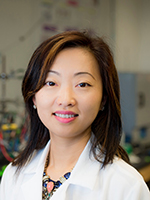Inspired by her father, motivated by curiosity, and driven by her passion for connecting people, Shirley Meng, a professor of nanoengineering at the University of California, San Diego, discovered her love for science.
Although, she had originally thought her interests would lead her to pursue another path, a career in law.
However, because of the instability of the law system in China, where Meng is originally from, her father encouraged Meng to pursue other opportunities. That’s when she began considering a career in the sciences.
She thought back to the time when as a child, her father, a civil engineer, would bring home blueprints at night.
“I remember my father always bringing back these blueprints and working on designs and drawing. I thought that was pretty cool. You can actually also see some of the dams he built today. He helped a lot of people in China,” said Meng.
That, coupled with professors who showed Meng that by becoming an engineer, she could too connect to people and have an impact on society, lead her into the engineering field.
And when the opportunity arose, a full scholarship including living and tuition expenses in Singapore, she knew she had to take it. “It was too good to say no,” said Meng.
It was too with the help of the Singapore government that Meng took on a rigorous seven-month program to learn English before beginning her studies.
“Yes, I’m very grateful today. Singapore provided the wonderful opportunity for me to go to their country and receive an education I probably wouldn’t have been able to get in China,” said Meng looking back.
Singapore also played a hand in continuing her education in the United States through the Singapore-MIT Alliance for Research and Technology (SMART) program, MIT’s largest international research programme. Meng was one of those students selected, receiving a full scholarship, including living expenses, to attend MIT.
Meng went on to receive her PhD in advance materials for micro & nanosystems from the Singapore-MIT Alliance in 2005, after which she worked as a postdoc research fellow and became a research scientist at MIT.
Each year, Meng spends a few months in Singapore to work on research, along with MIT professors who teach or coach graduate students in Singapore.
Why all the help from Singapore, one may ask?
“I think Singapore really envisioned that the human capital —I mean, we have a very limited number of citizens, I believe right now it’s about 4.5 million —I believe they really consider it as an investment,” said Meng, adding, “Singapore also continues to collaborate with other top universities in the world like Cambridge University.”
Want to learn more about Shirley Meng’s journey into the science field? Including how she became the founder of Sustainable Power and Energy Center at the University of California, San Diego, progress in regards to women in STEM, and her thoughts on energy efficiency: listen to her full interview live on the ECS podcast!
Meng recently coauthored the paper “Perspective—Fluorinating Interphases” now featured in the ECS Journal of The Electrochemical Society’s JES Focus Issue of Selected Papers from IMLB 2018, which focuses on battery and energy storage related research.
Learn more about fluorinating interphases, and why the research team believes it is the key to the next generation of the battery chemistries.



